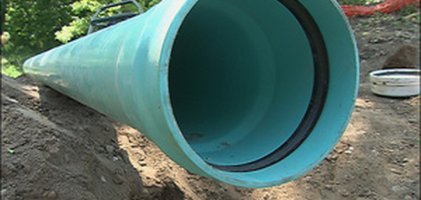ThomasT
REGISTERED
Is it possible to put these three utilities in the same trench 30 inches deep.
Your premier resource for building code knowledge.
This forum remains free to the public thanks to the generous support of our Sawhorse Members and Corporate Sponsors. Their contributions help keep this community thriving and accessible.
Want enhanced access to expert discussions and exclusive features? Learn more about the benefits here.
Ready to upgrade? Log in and upgrade now.
Given that you are in Pasadina Ca. the sewer pipe will most likely be ABS. No separation required and that applies to gas pipe as well.
Sometimes you just don't have the room.The whole "not in the same trench" thing always struck me as a silly way to frame the issue. The code should just specify a minimum separation, horizontal and/or vertical. I can't see how it matters if you get that separation by digging one wide trench or two smaller trenches.
Cheers, Wayne
I don't understand what you mean--the code should just specify the required separation (possibly with different options on horizontal separation depending on whether you also have a vertical separation). How you get there, with one trench or two, is immaterial. If site conditions somehow make one trench more feasible than two, that's fine, just make the trench wide enough.Sometimes you just don't have the room.
If you have room to dig two trenches (or one wide trench), then you can use cheaper material for your sewer pipe. If you don't have the room, then you have the option of using more expensive material and sharing the trench.I don't understand what you mean--the code should just specify the required separation (possibly with different options on horizontal separation depending on whether you also have a vertical separation). How you get there, with one trench or two, is immaterial. If site conditions somehow make one trench more feasible than two, that's fine, just make the trench wide enough.
OK, sure that makes sense. But that's unrelated to my comment to which you replied, hence my confusion.If you have room to dig two trenches (or one wide trench), then you can use cheaper material for your sewer pipe. If you don't have the room, then you have the option of using more expensive material and sharing the trench.
The material we often see outside of buildings is a PVC material, but they are not glued and therefore are not permitted to be used within the building. They are green and are fit together by a compression joint, commonly called "SDR". Apparently on civil sheets "SDR" is an acronym for "Standard Dimension Radius" but the name stuck and is now what they call this pipe.Not once as in never did this become an issue. Nobody uses anything other than ABS or PVC. The only peop;e that use clay pipe are the utility companies.

Very common when buildings are hundreds of feet from connection points.It's common in this part of the Pacific NW.
